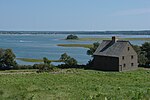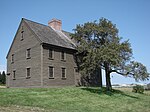Castle Hill (Ipswich, Massachusetts)

Castle Hill is a 56,881 sq ft (5,284.4 m2) mansion in Ipswich, Massachusetts, which was completed in 1928 as a summer home for Mr. and Mrs. Richard Teller Crane, Jr. It is also the name of the 165-acre (67 ha) drumlin surrounded by sea and salt marsh that the home was built atop. Both are part of the 2,100-acre (850 ha) Crane Estate, located on Argilla Road. The estate includes the historic mansion, 21 outbuildings, and landscapes overlooking Ipswich Bay on the seacoast off Route 1, north of Boston. Its name derives from a promontory in Ipswich, Suffolk, England, from which many early Massachusetts Bay Colony settlers immigrated. The estate is a relatively intact work from the Country Place Era of the turn of the 20th century, when wealthy families built extensive country estates. The Crane Estate includes architectural and landscape designs from at least seven firms or individuals of national reputation, including the Olmsted Brothers and Shepley, Rutan and Coolidge, and it is extensively documented. In recognition of its state of preservation and design, it was designated a National Historic Landmark in 1998. The property is now owned by The Trustees of Reservations and is open to the public.
Excerpt from the Wikipedia article Castle Hill (Ipswich, Massachusetts) (License: CC BY-SA 3.0, Authors, Images).Castle Hill (Ipswich, Massachusetts)
The Back Avenue,
Geographical coordinates (GPS) Address Nearby Places Show on map
Geographical coordinates (GPS)
| Latitude | Longitude |
|---|---|
| N 42.685144444444 ° | E -70.779205555556 ° |
Address
Forecourt
The Back Avenue
Massachusetts, United States
Open on Google Maps











